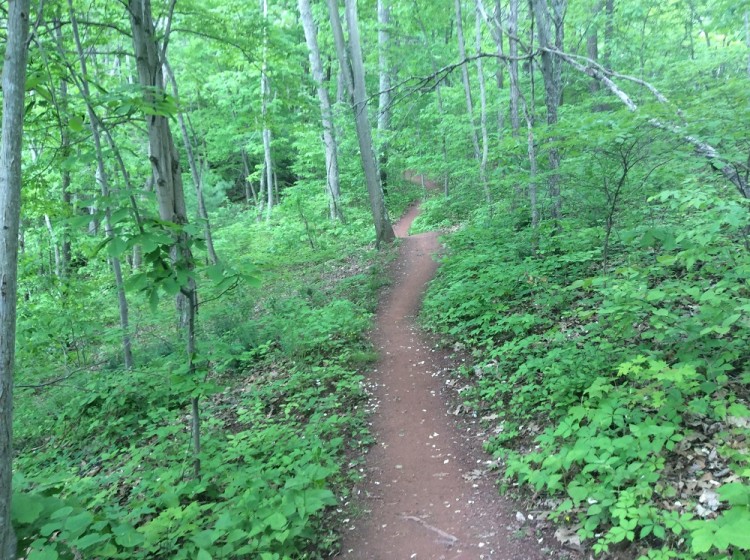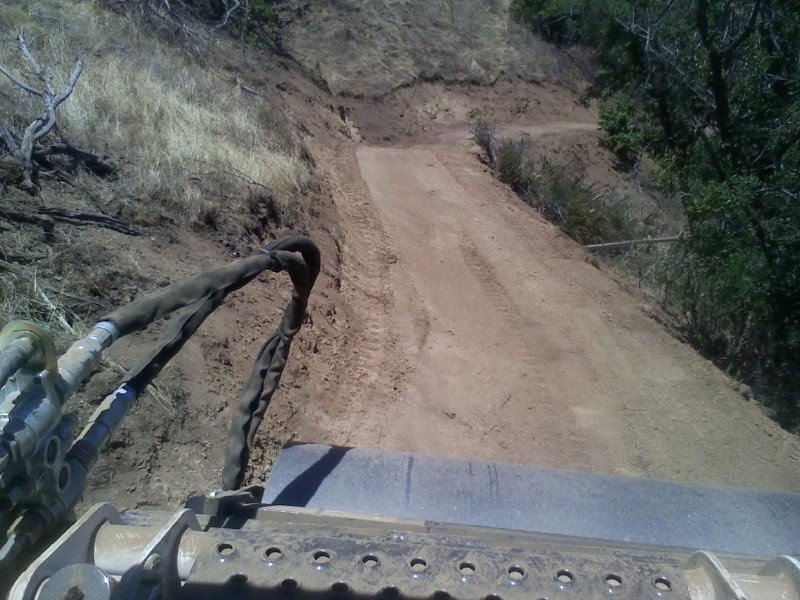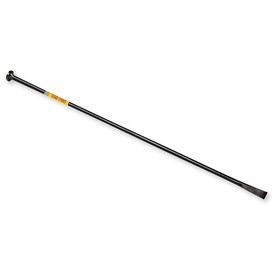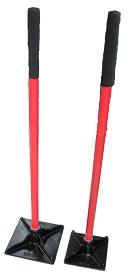While trail building, whether bench cutting or building structures, it is critical that the trail tread and soil under structures get compacted. If not, the probability of a structure settling increases, and brand new trails can become cupped and form an outside berm. The berms can trap water, increase the chance of erosion, and puddle formation. If trail tread is not compacted, trail users will do the packing that should ultimately be done during construction.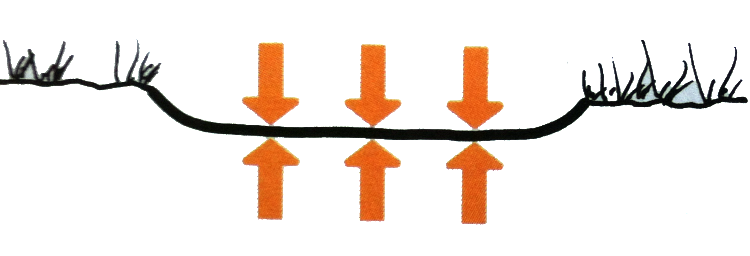
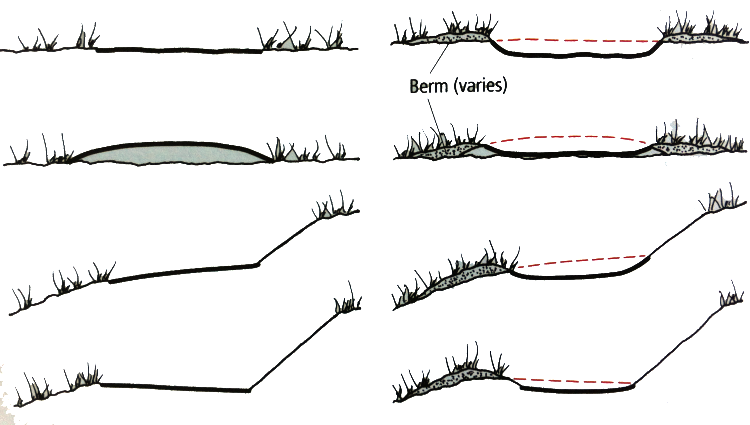
image source
Even if you pack/compact the trail well during construction over time berms can form via user displacement and erosion. Eventually most will have to be debermed, though not as frequently if the grade reversals are frequent enough to overcome the ills of erosion which can be exacerbated by a cupped trail. In dry climates, displacement due to soil blowing away in the wind can cause cupping as well. Southern California suffered from this problem, especially in high use areas.
If fortunate enough to be using an excavator, you only need to concern yourself with packing the center of the tread as the tracks do more than enough to pack the inner and outer edges.
If not using a plate compactor/vibratory plate or rammer, a vibratory roller is a great means to get the job done. The one below is attached to a Bobcat on a trail in California:
Different mechanical means of compacting soil are discussed in detail here, and in this soil compaction handbook, but they don’t cover hand tamping methods. A great deal of compaction can be obtained by packing by using hand tamps, and even more from the round end of a digging bar or even the heels of boots as compaction is a function of psi-pounds per square inch. Sledge hammers work too.
Compacting the subsoil below where gravel will be placed for structures helps lower the risk of settling, and in frost heave prone areas compacting the subsoil is even more important as it will help lower the risk of heave. If the subsoil or trail tread is dusty and bone-dry, add water! Compared to moist soil, low moisture content soils aren’t as likely to compact enough to lower the risks of settling and frost heave.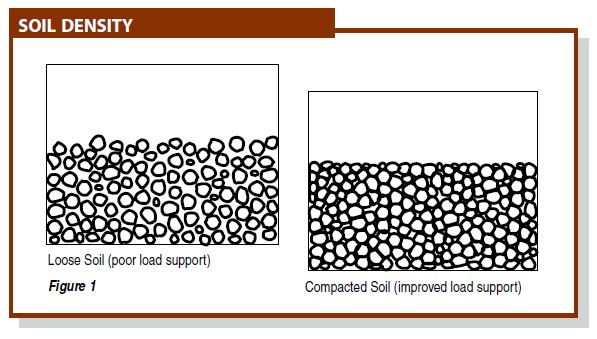 Compacted soils not only support loads better, they are not as permeable, slowing water movement to ice lenses, and they hold less water with which to add to the lenses because compacting soil lowers porosity (and the soil’s water holding capacity, in particular it’s field capacity)
Compacted soils not only support loads better, they are not as permeable, slowing water movement to ice lenses, and they hold less water with which to add to the lenses because compacting soil lowers porosity (and the soil’s water holding capacity, in particular it’s field capacity)
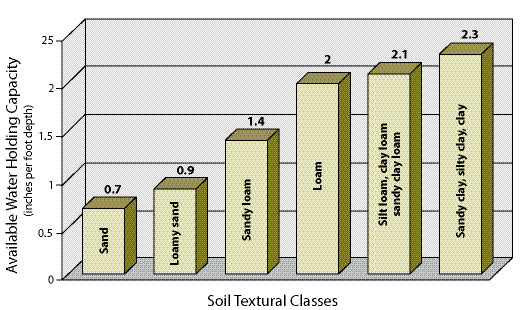
Two slightly different comparisons of frost heave potential by soil type: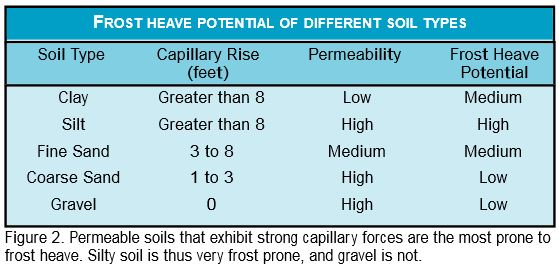
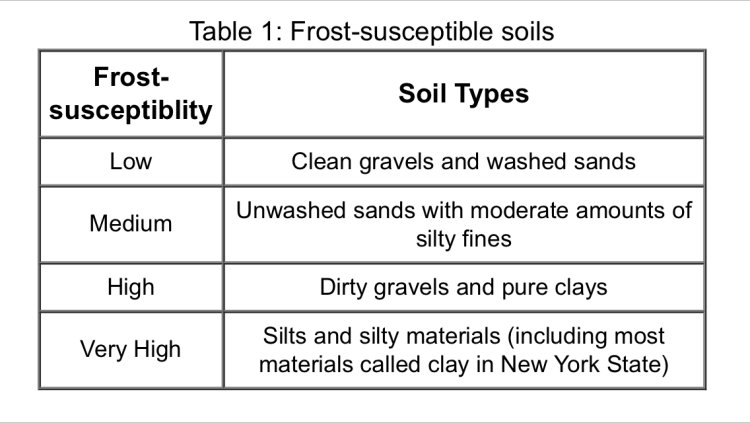
How moist should soil be for compaction? source:
- For soil moisture content use the hand test:
- Squeeze a ball of soil in your hand. If it’s powdery and won’t hold a shape, it’s too dry; if it molds into a ball then breaks into a couple of pieces when dropped, it’s about right; if it leaves moisture on your hand and doesn’t break when dropped, it’s too wet.
- Clay that you can push your thumb a few inches into with moderate effort has a bearing strength in the range of 1000 to 2500 psf
- Loose sand that you can just barely push a #4 rebar into by hand has a bearing capacity of 1000 to 3000 psf
- Sand that you can drive a #4 rebar into about 1 foot with a 5-pound hammer has a bearing capacity over 2000 psf
- Preform a Standard Proctor test to determine the exact moisture content for the maximum density possible (see videos below).
The act of compacting soil that is “too wet” will typically move soil to the sides of compaction impact because its too slippery and plastic. All the pore spaces are filled with water, and possibly even ‘floating,’ so compaction isn’t going to reduce pore spaces as effectively as ‘moist’ soil where it will stay put and pack down thanks to adhesive forces between water and soil. Water has a lubricating effect that helps particles slide into tighter positioning. If too dry the soil loses adhesive properties and is not as “plastic” or slick so it won’t pack down as well, if at all.
There are times when building trails that we can’t compact, as the moisture content is less than (or more than) ideal and there is no (or more) water coming in the foreseeable future. Plan your work and order of operations carefully. If you are going to build structures, do it when the moisture content is right, or add your own even if you have to pipe it in or transport it over by bucket. If you do add water be weary of how much. You may have to soak it well and let it sit several hours or overnight before compacting.
The hand test above should suffice, but a Proctor test will tell you exactly. Below are the optimum moisture content percentages:
| Soil Description | USCS Class | Compacted Dry Unit Weight | Optimum Moisture Content (%) | |
|---|---|---|---|---|
| (lb/ft3) | (kN/m3) | |||
| Gravel/sand mixtures: | ||||
| well-graded, clean | GW | 125-134 | 19.6-21.1 | 8-11 |
| poorly-graded, clean | GP | 115-125 | 18.1-19.6 | 11-14 |
| well-graded, small silt content | GM | 119-134 | 18.6-21.1 | 8-12 |
| well-graded, small clay content | GC | 115-125 | 18.1-19.6 | 9-14 |
| Sands and sandy soils: | ||||
| well-graded, clean | SW | 109-131 | 17.2-20.6 | 9-16 |
| poorly-graded, small silt content | SP | 94-119 | 15.7-18.6 | 12-21 |
| well-graded, small silt content | SM | 109-125 | 17.2-19.6 | 11-16 |
| well-graded, small clay content | SC | 106-125 | 16.7-19.6 | 11-19 |
| Fined-grained soils of low plasticity: | ||||
| silts | ML | 94-119 | 14.7-18.6 | 12-24 |
| clays | CL | 94-119 | 14.7-18.6 | 12-24 |
| organic silts | OL | 81-100 | 12.7-15.7 | 21-33 |
| Fine-grained soils of high plasticity: | ||||
| silts | MH | 69-94 | 10.8-14.7 | 24-40 |
| clays | CH | 81-106 | 12.7-18.6 | 19-36 |
| organic clays | OH | 66-100 | 10.3-15.7 | 21-45 |
It is critical to compact the subsoil, and the crush/gravel below structures, but a little confusing as a low permeable soil is desired, and a highly permeable crush is desired (i.e. we want gavel, not all fines and rock dust). A compacted soil is desired to reduce its permeability (and the capillary action that draws water to ice lenses), and on the other hand a highly permeable crush is desired so it won’t hold water or let it move to lenses- and in both soil and crush, settling is an enemy that can disturb the completed work that sometimes takes hours to build or “set.” Many trail builders doing rock work use the word “set” to mean a rock is in it’s “in place” with little risk of moving. If the act of settling occurs because the subsoil was not compacted, was a supposedly “set” rock actually set? The same could be said for finishing off out sloped tread. If not compacted enough and users create a cupped tread with an outer berm…was the tread really finished?
1. some details not covered in the other protocol video below:
2.Standard Proctor procedure
Compaction around trees
Around trees compaction is not so good, but not putting a trail next to trees is nearly impossible in most of the country, and provides a nice user experience. One solution is to add soil over roots where trees are crossed by trails in their drip line. Another option is to not deduff in this area and/or add more mulch to protect roots, although mulch is typically not an ideal trail tread material as it can eventually turn to organic muck in time. Regardless, most trees will do fine with a trail in close proximity. As long as the tree is not totally encircled by trail it should survive– at least for trees bigger than your forearm.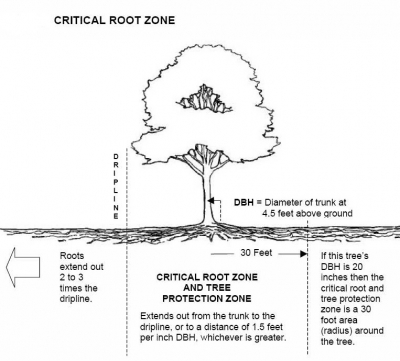
Compaction tolerant trees:
source: Soil compaction is a complex set of physical, chemical, and biological constraints on tree growth. Principle components leading to limited growth are the loss of aeration pore space, poor gas exchange with the atmosphere, lack of tree available water, and mechanical impedance of root growth. There are significant genetic differences between tree species for tolerating various levels of soil compaction.
…Tolerant species were selected for their effectiveness in reacting to mechanical damage quickly, in surviving anaerobic soil conditions, and in adjusting their root systems to new conditions. This is not a comprehensive list and is only provided to show average species examples. Chronic and severe compaction will kill any tree. Some species, varieties, and individuals may tolerate various compacted soil conditions better than others.
| scientific name | common name |
| Acer negundo | boxelder |
| Acer rubrum | red maple |
| Acer saccharinum | silver maple |
| Alnus spp. | alders |
| Betula nigra | river birch |
| Carya aquatica | water hickory |
| Carya illinoensis | pecan |
| Celtis laevigata | sugarberry |
| Celtis occidentalis | hackberry |
| Cercis canadensis | redbud |
| Crataegus spp. | hawthorns |
| Diospyros virginiana | persimmon |
| Fraxinus spp. | ash |
| Gleditsia triacanthos | honeylocust |
| Ilex spp. | holly |
| Juglans nigra | black walnut |
| Juniperus virginiana | Eastern redcedar |
| Liquidambar styraciflua | sweetgum |
| Magnolia virginiana | sweetbay |
| Nyssa spp. | tupelo/black gum |
| Persea borbonia | redbay |
| Pinus elliottii | slash pine |
| Pinus taeda | loblolly pine |
| Platanus spp. | sycamore/planetree |
| Populus spp. | cottonwood/aspen |
| Quercus bicolor | swamp white oak |
| Quercus falcata | Southern red oak |
| Quercus imbricaria | shingle oak |
| Quercus laurifolia | laurel oak |
| Quercus lyrata | overcup oak |
| Quercus macrocarpa | bur oak |
| Quercus michauxii | swamp chestnut oak |
| Quercus nigra | water oak |
| Quercus nuttallii | Nuttall oak |
| Quercus palustris | pin oak |
| Quercus phellos | willow oak |
| Quercus rubra | red oak |
| Quercus shumardii | Shumard oak |
| Robinia pseudoacacia | black locust |
| Salix spp. | willows |
| Taxodium distichum | baldcypress |
| Ulmus spp. | elms |
Soil piled up around trees at Allegrippis, PA to provide grade reversals and protect them from mechanical damage from excavators passing over them: